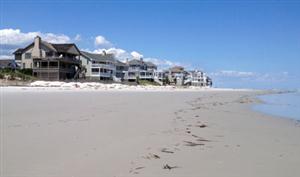Four coastal communities experiencing chronic erosion problems near inlets are developing studies to harden their shorelines based on a change of state law. But questions remain about how the recently passed law will be administered and how any damage from the hardened shoreline will be measured.
The N.C. General Assembly in 2011 approved a law, authorizing up to four small jetties, called terminal groins, along the coastline adjacent to tidal inlets, overturning the state’s decades old ban on hardened structures on the ocean. A terminal groin is a wall, usually made of rock, that extends out toward the ocean and is designed to trap sand and prevent erosion. It is usually built perpendicular to the shoreline.
Supporter Spotlight
The decision to permit terminals groins follows years of lobbying by some beach communities facing severe erosion and the potential loss of property value if oceanfront houses are removed or taken by the sea. A 2010 study by the N.C. Coastal Resources Commission found that terminals groins in combination with beach re-nourishment could control erosion at the end of a barrier island. Hardened structures had been illegal in North Carolina since 1985 because they can accelerate erosion problems on adjacent beaches.
Braxton Davis, director of the N.C. Division of Coastal Management, which oversees the CAMA permitting process, said it’s still unknown whether the Coastal Resources Commission will eventually develop administrative rules to guide the construction of terminal groins.The study said the erosional effects of terminal groins are the main concern, but they are variable. If it is built so that it disrupts the movement of sand, the groin can trigger increased erosion on beaches “downstream.” The study estimated that is would cost $3.5 million to $10 million to build a groin and to perform the necessary beach re-nourishment, depending on the length of the structure and building material.
“We have a process in place that can handle the whole permit process,” Davis said. “As we work through the first application, we may find things that it would be helpful to have rules to clarify.”
Communities seeking to build groins must commission an environmental impact study analyzing alternatives and showing the groin is the preferred alternative. Among other things, the new law also requires that applicants monitor the groins and provide financial assurance that they have the money to repair any damage and to remove the structure if necessary.
Applicants must obtain a Coastal Area Management Act major permit from the N.C. Division of Coastal Management, a permit from the N.C. Division of Water Quality and a federal permit from the Army Corps of Engineers.
Supporter Spotlight
Figure Eight Project
To date, Figure Eight Island, a privately developed five-mile-long island in New Hanover County, has advanced the farthest in the planning process to build a terminal groin. Its purpose is to protect oceanfront houses threatened by erosion near the north end of the island at Rich Inlet.
Earlier this year, the Corps of Engineers released a draft environmental impact statement outlining alternatives including the construction of a 1,600-foot terminal groin along the southern shoulder of the inlet extending 700 feet into the ocean to protect two miles of eroding oceanfront. The design is intended to control shoreline erosion south of Rich Inlet and to protect property. Sandbags have been placed around 20 houses threatened by erosion near Rich Inlet. One house has since been relocated.
 Sandbags protect oceanfront houses on Figure Eight Island. |
The plan includes building a groin and placing sand along more than a mile of shoreline along the oceanfront and Rich Inlet. The estimated initial construction cost for the groin and beach re-nourishment is $5.9 million, according to the study. Ongoing replenishment of sand on the shoreline, using sand dredged from periodic maintenance of Nixon Channel, is estimated to cost $1.8 million every five years. This is the preferred alternative of the Figure Eight Homeowners’ Association.
The association has tried to shore up the eroding north end of the island with a total of 1.8 million cubic yards of sand since 1993. But their efforts have failed to stabilize the beach because of the high erosion rate in the area.
The Corps is receiving comments on the draft environmental study of the project until July 20.
Mike Giles, an advocate for the N.C. Coastal Federation, said a groin would pose a navigational hazard and affect access to public trust waters. “People who built near an inlet knew what they were getting into,” Giles said. “They rolled the dice.
Doug Huggett, manager of the Division of Coastal Management’s major permits section, said Figure Eight is the farthest along in the planning process and the earliest a terminal groin could be constructed would be the fall of 2013.
The law sets forth broad requirements as the basis for building terminal groins. Environmental groups including the federation have urged the Coastal Resources Commission to adopt specific rules to implement the law and to ensure its requirements are applied and enforced consistently.
Are Rules Needed?
 Geoff Gisler |
Geoff Gisler, an attorney with the Southern Environmental Law Center, said the existing law doesn’t provide the level of detail necessary to clarify important considerations such as how to calculate when a terminal groin is causing negative effects to adjacent beaches and what financial guarantees would be required to pay for removal of the groin.
“When you are dealing with coastal geology, the legislature isn’t a good forum for working out details,” Gisler said. “The statute doesn’t provide a level of detail to clarify how an agency should evaluate permits and what the requirements in the statute should mean. There is ambiguity in what different things mean.”
But Huggett said the law provides enough guidance that the staff is not recommending at this point that the Coastal Resources Commission develop administrative rules.
“Our view is the legislation gives us a lot of guidance that a rule normally would,” Huggett said.
The law requires a community to provide financial assurances to cover the removal of a groin if it harms neighboring shorelines. But Huggett acknowledged that developing long-term monitoring processes to measure accurately whether a groin is causing accelerated erosion on downstream beaches posed a major challenge the staff would have to tackle.
Every one of the groin projects is going to have its own unique measurement criteria for determining beach erosion before and after the construction of a groin, Huggett said.
“It’s certainly one of the more difficult components of the law we’re going to have to deal with,” he said.
Huggett said the staff would bring issues to the CRC’s attention if they see scenarios with construction of terminal groins that do need rulemaking.
Other Groin Projects
In addition to Figure Eight Island, three other communities are in the early stages of seeking permits to build terminal groins.
Bald Head Island—An exclusive island near the mouth of the Cape Fear River in Brunswick County, Bald Head has applied to the Corps of Engineers to build a terminal groin at the western end of South Beach to address accelerating erosion.
A portion of South Beach on Bald Head Island has retreated by as much as 400 feet since 2000, despite the placement of 6 million cubic yards of sand to rebuild the beach. Sixteen temporary sand-filled tube structures have been in place since 1996 to try and stabilize the western end of South Beach. Despite all that, a portion of South Beach continues to disappear. In 2011, Bald Head built 350 feet of sandbags near the last groin to protect nearby houses, roads and dunes.
The Corps held a meeting in March to get input on a draft environmental study of the project. The draft environmental study is expected to be published at the end of 2012, and a public hearing will then be held.
Holden Beach—Holden Beach has asked the Corps for authorization to install a terminal groin on the western side of Lockwood Folly Inlet and place more sand along the eastern end of Holden Beach, according to the Federal Register notice. The eastern end of Holden Beach has experienced severe erosion and the town has undertaken periodic beach re-nourishment.
The Corps held a public meeting in March to receive input on issues that should be addressed in the draft environmental study. The final location of the terminal groin is still to be determined. The study is evaluating two alternatives designs and locations. One alternative is a 1,600-foot rock structure located along the western shoulder of the inlet. The second alternative is a shorter 400- to 600-foot structure near the end of Ocean Boulevard East.
A draft version of the environmental study is expected to be published in early 2013 for public comment.
Ocean Isle Beach — In April, the town hired engineering consultants to do an environmental impact study of building a groin on the eastern end of Ocean Isle.
In a presentation to the town board, engineers with Coastal Planning and Engineering, a consulting group involved in several of the projects, said that construction of a terminal groin would extend the cycle for re-nourishing the beach from three years to six years, resulting in costs savings. They estimated that continuing erosion to the east end of the island over the next 20 years would result in damages costing approximately $12.6 million. The consultants estimated March 2016 for completion of the design, permitting and construction of a terminal groin.







